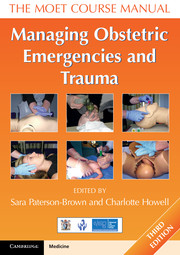Book contents
- Frontmatter
- Dedication
- Contents
- Working Group
- About the authors
- Acknowledgements
- Abbreviations
- Section 1 Introduction
- Section 2 Recognition
- Section 3 Resuscitation
- Section 4 Trauma
- Section 5 Other medical and surgical emergencies
- Section 6 Obstetric emergencies
- 24 Pre-eclampsia and eclampsia
- 25 Major obstetric haemorrhage
- 26 Caesarean section
- 27 Placenta accreta and retained placenta
- 28 Uterine inversion
- 29 Ruptured uterus
- 30 Ventouse and forceps delivery
- 31 Shoulder dystocia
- 32 Umbilical cord prolapse
- 33 Face presentation
- 34 Breech delivery and external cephalic version
- 35 Twin pregnancy
- 36 Complex perineal and anal sphincter trauma
- 37 Symphysiotomy and destructive procedures
- 38 Anaesthetic complications in obstetrics
- Section 7 Triage and transfer
- Section 8 Human issues
- Index
38 - Anaesthetic complications in obstetrics
- Frontmatter
- Dedication
- Contents
- Working Group
- About the authors
- Acknowledgements
- Abbreviations
- Section 1 Introduction
- Section 2 Recognition
- Section 3 Resuscitation
- Section 4 Trauma
- Section 5 Other medical and surgical emergencies
- Section 6 Obstetric emergencies
- 24 Pre-eclampsia and eclampsia
- 25 Major obstetric haemorrhage
- 26 Caesarean section
- 27 Placenta accreta and retained placenta
- 28 Uterine inversion
- 29 Ruptured uterus
- 30 Ventouse and forceps delivery
- 31 Shoulder dystocia
- 32 Umbilical cord prolapse
- 33 Face presentation
- 34 Breech delivery and external cephalic version
- 35 Twin pregnancy
- 36 Complex perineal and anal sphincter trauma
- 37 Symphysiotomy and destructive procedures
- 38 Anaesthetic complications in obstetrics
- Section 7 Triage and transfer
- Section 8 Human issues
- Index
Summary
Objectives
On successfully completing this topic, you will be able to:
appreciate the risks posed to the pregnant women by anaesthetic drugs and techniques
understand anaesthetic emergency problems affecting the pregnant woman.
Introduction and incidence
The proportion of women dying from complications of anaesthetics has declined markedly over the last 20 years. Deaths from airway-related problems have declined over the last ten years of Confidential Enquiry reports, but failure to ventilate the lungs is still a major concern. The risk of death from an obstetric general anaesthetic has been estimated at one in 20 000. In 2011, a large series of obstetric patients in Canada undergoing general anaesthesia confirmed that difficult intubation still occurs in 3.3% (range 1.3–16.3%) and failed intubat ion in one in 250 patients. The events occur almost exclusively in emergency cases and are associated with the most urgent of cases, inexperienced staff and failure to follow standard practice. Box 38.1 indicated the problems highlighted by the Confidential Enquiry reports. However improved assessment and anticipation of airway problems has led to series with fewer failed intubations.
Difficult intubations – prevention better than cure
Preparation for an intubation
Appropriately trained staff – anaesthetist and assistant.
Correct equipment checked and available to hand, including airway adjuncts for difficult airways.
Position of the woman optimised.
- Type
- Chapter
- Information
- Managing Obstetric Emergencies and TraumaThe MOET Course Manual, pp. 437 - 450Publisher: Cambridge University PressPrint publication year: 2014

